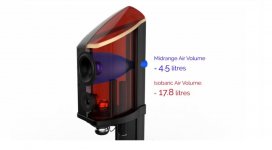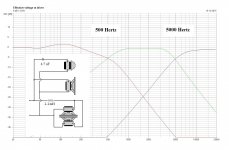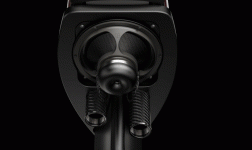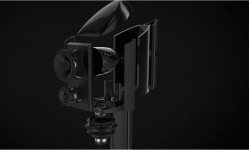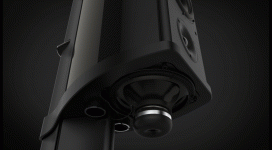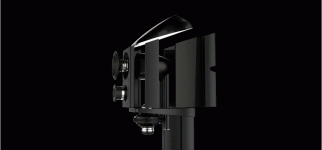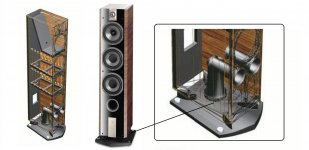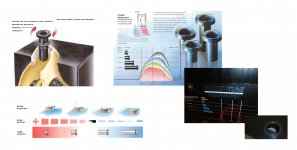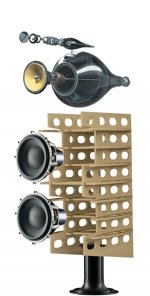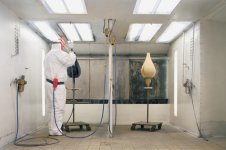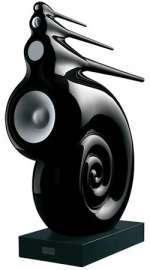Can someone please give me the basics of possible issues one would run into by having different length ports as in the WB endeavour speakers?
http://wilson-benesch.com/wp-conten...eavour-red-tulip-carbon-fibre-loudspeaker.jpg
http://wilson-benesch.com/wp-conten...eavour-red-tulip-carbon-fibre-loudspeaker.jpg
That's one helluva interesting piece of technology, but nowhere in the 25 page white paper on this product could I find an explanation for that aspect, which is a bit surprising when they go to the trouble of describing the advantages of carbon nanotech sub enclosures for the midrange driver. Gee, even a tube of pressed paperboard has proven to work fine for that
I've seen the future, and it's carbon - only if minus the di-oxide
All kidding aside, these I'd love to hear
I've seen the future, and it's carbon - only if minus the di-oxide
All kidding aside, these I'd love to hear
Last edited:
Double ports. If they are different size lengths (and same size diameters) connecting to the same Helmholtz chamber, then they have different frequencies, I have some Focals and they have a lower port (bottom) with lower frequency tuning reflecting to the floor. It might have an impedance curve with lower max. peaks and spread in frequency.
to quote a smart guy I know:
That said - they certainly do look cool and stuff, and if I attended hi-fi shows these days, I'd take the walk down the hall to hear them
I must say, when you read WB's white paper that delves deep into not only the product's design architecture, but also their material choices, engineering of drivers and fastidious - perhaps excessive?- attention to detail, it's hard not to conclude that however much is revealed, they know something we don't. Which I think is sorta part of how high end audio works.unless they've re-written the laws of physics, I'm in the same camp as I reckon you are - i.e. re my puzzlement about the staggered port vent lengths.
Since the ducts are sharing the same volume, they'll just behave as the mean length and the total summed cross section, notwithstanding any added frictional effects (the ducts don't look small enough for that to play any significant role).
That said - they certainly do look cool and stuff, and if I attended hi-fi shows these days, I'd take the walk down the hall to hear them
from the same smarter than me guy (like that's much of a stretch)
The latter (multiple high aspect ratio slot ports) is something incorporated in virtually all of Planet10's non horn designs - at least the scores of those I've built over the past dozen or so years. They definitely make for an extra step or two in assembly, but seem to be well worth the trouble in terms of control.If two vents of different dimensions are attached to the same volume, you don't get two different resonant / tuning frequencies: all that will happen is that you will get a single resonant frequency which is determined by the mean length and the total cross sectional area of the two vents. The exact behaviour of the overall response may vary if there is some additional mechanism at work , such as ducts that individually have a very small cross sectional area -the added friction may case some damping effect.
I already read about them, WB. I can't remember about their topology. An Xray would be nice. Someone already said that the distance to the floor it's high to work for the benefict of LF. The pdf shows a reflex (or aperiodic) mid driver chamber in the shape of a bottle with back port and a double sub, face to face, isobaric with a dual system of ports. Now, this was implemented with a B&W sub (I don't think is the case here) that interchangable ports, with different size lengths could change the low frequency/alignment.
Wilson Benesch Endeavour
Air Volume Mid: 4.5 Liters reflex (alignment?)
Air Volume Woofers: 17.8 Liters Isobaric (series or parallel?/alignment?).
https://www.youtube.com/watch?v=C5P9DkF74rQ#t=20
Wilson Benesch crossover (similar type below) would be something like a 1. order crossover type and a mid driver directly connected in a 2.5/3-way fashion.
Note. Of course polarity from one woofer needs to be reversed if drivers connected in parallel.
Wilson Benesch – High end audiophile speakers from the UK – The Future is Carbon
Drivers
1 x 25mm (1”) Wilson Benesch Semisphere Tweeter
1 x 170mm (7”) Wilson Benesch Mid-Range Tactic II Drive Unit
2 x 170mm (7”) Wilson Benesch Isobaric Tactic II Drive Unit
Crossover Frequency:
500Hz, 5kHz
First Order Tweeter Crossover, ferrofluid damping
Mid range drive unit directly coupled to amplifier (alignment?),
First Order Bass roll-off.
Measurements
2.5-way Standmounted Monitor
Nominal Impedance: 6 Ohms Nominal / 4 Ohms Minimal
Sensitivity: 89dB @ 1-Meter on axis, 2.83V Input
Frequency Response: 38Hz - 30KHz +/- 2dB
Dimensions
Height: 1475mm (58“)
Width: 245mm (9.6”)
Depth: 435mm (17.1”)
Volume: 22L
Weight per Channel: 100-kg (220 lbs)
Air Volume Mid: 4.5 Liters reflex (alignment?)
Air Volume Woofers: 17.8 Liters Isobaric (series or parallel?/alignment?).
https://www.youtube.com/watch?v=C5P9DkF74rQ#t=20
Wilson Benesch crossover (similar type below) would be something like a 1. order crossover type and a mid driver directly connected in a 2.5/3-way fashion.

Note. Of course polarity from one woofer needs to be reversed if drivers connected in parallel.
Wilson Benesch – High end audiophile speakers from the UK – The Future is Carbon
Drivers
1 x 25mm (1”) Wilson Benesch Semisphere Tweeter
1 x 170mm (7”) Wilson Benesch Mid-Range Tactic II Drive Unit
2 x 170mm (7”) Wilson Benesch Isobaric Tactic II Drive Unit
Crossover Frequency:
500Hz, 5kHz
First Order Tweeter Crossover, ferrofluid damping
Mid range drive unit directly coupled to amplifier (alignment?),
First Order Bass roll-off.
Measurements
2.5-way Standmounted Monitor
Nominal Impedance: 6 Ohms Nominal / 4 Ohms Minimal
Sensitivity: 89dB @ 1-Meter on axis, 2.83V Input
Frequency Response: 38Hz - 30KHz +/- 2dB
Dimensions
Height: 1475mm (58“)
Width: 245mm (9.6”)
Depth: 435mm (17.1”)
Volume: 22L
Weight per Channel: 100-kg (220 lbs)
Building the unit in-house has allowed Wilson Benesch to tailor the tweeter’s low-frequency roll-off to suit their preferred first-order crossover topology, eschewing ferrofluid damping in favor of a closed and carefully optimized rear chamber. (...)
The forward facing midrange unit is run wide open, relying entirely on mechanical roll-off to blend it to the drivers above and below it in the range. Both the tweeter and the bass units are integrated using gentle first-order slopes to attenuate their output above 500Hz and below 5kHz.
(although nominally a two-way, first-order electrical but two-and-a-half-way acoustical filter, it is actually much closer to a three-way system in practice)
Wilson Benesch Endeavour Loudspeakers - The Audio Beat - www.TheAudioBeat.com
Attachments
Last edited:
it's hard not to conclude that however much is revealed, they know something we don't. Which I think is sorta part of how high end audio works.
That said - they certainly do look cool and stuff, and if I attended hi-fi shows these days, I'd take the walk down the hall to hear them
Or is it intellectual posturing, that ends up being meaningless?
If two vents of different dimensions are attached to the same volume, you don't get two different resonant / tuning frequencies: all that will happen is that you will get a single resonant frequency which is determined by the mean length and the total cross sectional area of the two vents
So for example; if two ports of two different lengths end up being the means, why do you not simply have the 'mean' port, other than to .... as you out it .... "look cool" (no disrespect to your good self)?
As for port material. does one really need carbon fibre ports? Meh ..

Does marketing win hands down in this case?
In this case because they don't fit in the back of the isobaric compound, they need to be two, to be one on each side of the drivers (symmetry) and sides of the mid enclosure (in the shape of a "Champagne") bottleneck on top.... if two ports of two different lengths end up being the means, why do you not simply have the 'mean' port,
https://www.youtube.com/watch?v=OiFhsA1bkDo
Professor Ward, on*Wilson Benesch TV - Isotactic Polypropylene (IPP)
Attachments
In this case because they don't fit in the back of the isobaric compound, they need to be two, to be one on each side of the drivers (symmetry) and sides of the mid enclosure (in the shape of a "Champagne") bottleneck on top.
https://www.youtube.com/watch?v=OiFhsA1bkDo
Professor Ward, on*Wilson Benesch TV - Isotactic Polypropylene (IPP)
But the ports start inside the enclosure are at the same height/length.
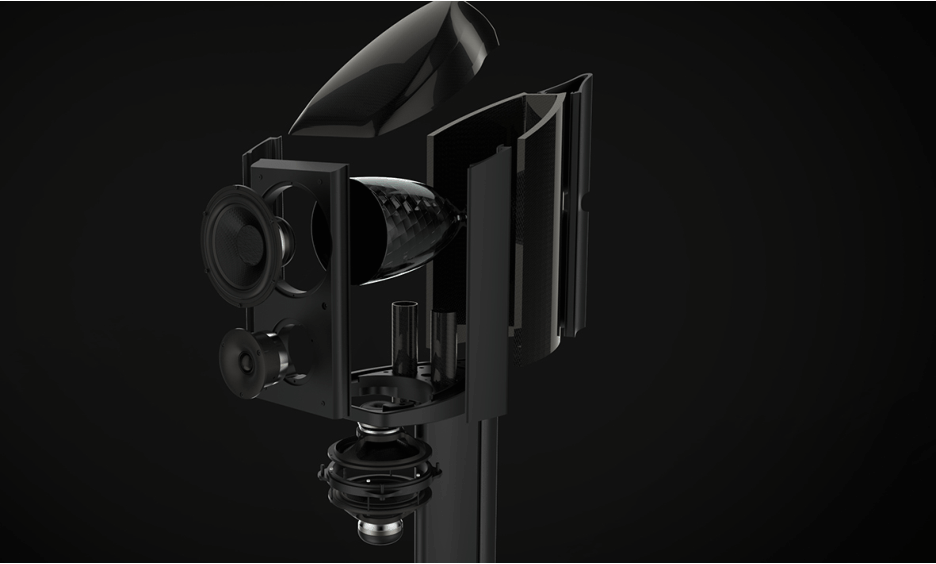
It's only outside where we see the actual differentiating lengths
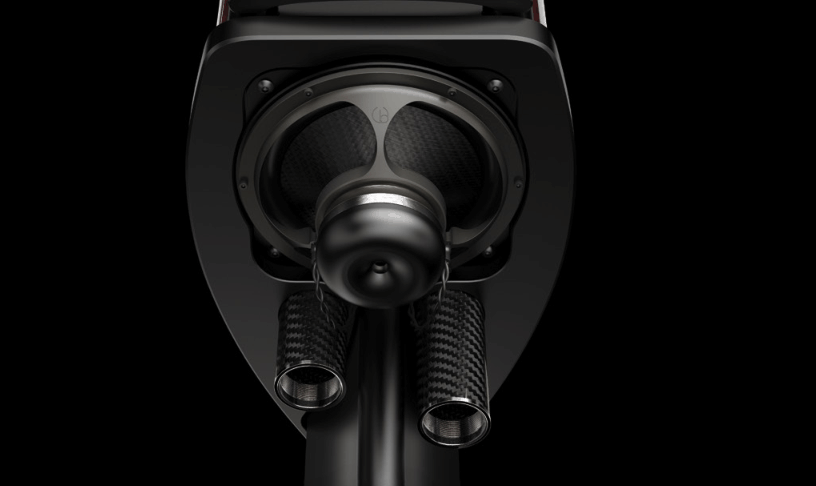
As for the Champagne bottle theory, Patrick talks about that in this thread, albeit in reverse in the interest of SPL.
Car Audio | DiyMobileAudio.com | Car Stereo Forum - View Single Post - How to Generate More SPL Without Spending a Penny
Here's seems to be another unsymmetrical dual port design
AREA DVD Hardware
https://goo.gl/WKattG - Translated
thinking about it, i assume it's no different than a 6th order bandpass ...
...sorry, what was i thinking
Last edited:
It always makes you wonder what is inside...
Inside the Focal Chorus 826 & 836 V_X-Ray (port system), Bowers & Wilkins Acoustitune Passive Sub (interchangeable ports). B&W 800D, 801, 802 type of midrange enclosure and B&W Nautilus.
links:
Wedgwood/B&W : rgproduct
B&W 800 Diamond review | What Hi-Fi?
Bowers & Wilkins 800D loudspeaker review Review - Equipment Reviews - Dagogo
Focal Chorus 826 V, high end floorstanding hifi speakers
Focal Chorus 836 V floorstanding hifi speakers for high end Home Audio system
Floor Standing - PJ Hifi
Inside the Focal Chorus 826 & 836 V_X-Ray (port system), Bowers & Wilkins Acoustitune Passive Sub (interchangeable ports). B&W 800D, 801, 802 type of midrange enclosure and B&W Nautilus.
links:
Wedgwood/B&W : rgproduct
B&W 800 Diamond review | What Hi-Fi?
Bowers & Wilkins 800D loudspeaker review Review - Equipment Reviews - Dagogo
Focal Chorus 826 V, high end floorstanding hifi speakers
Focal Chorus 836 V floorstanding hifi speakers for high end Home Audio system
Floor Standing - PJ Hifi
Attachments
But like many a PWK enclosure (in relation to all the aperiodic enclosure he builds in connection to the AD Designs subs), one starts to wonder if all these 'Fancy' designs are truly necessary, or simply something that the marketing department can use to push the buttons of the undiscerning consumer.
https://www.youtube.com/watch?v=UtN_RcJRR3c - AD Designs Acoustic Engineering Service
"Look I have a series coupled, aperiodic enclosure"
"Look at the fancy ports on myyyyyyy speakers"
"My driver are made from Kevlar .. the same stuff used in bullet proof vest"
"My driver are made of carbon fibre!"
As Peter Thomas points out; "it's not very sexy 'paper' is it? Carbon fibre sounds more interesting ... kevlar ..."
https://www.youtube.com/watch?v=Xz45IYZQMf0 - Peter Thomas of PMC Interview - Part 2 - The DSP Project
https://www.youtube.com/watch?v=UtN_RcJRR3c - AD Designs Acoustic Engineering Service
"Look I have a series coupled, aperiodic enclosure"
"Look at the fancy ports on myyyyyyy speakers"
"My driver are made from Kevlar .. the same stuff used in bullet proof vest"
"My driver are made of carbon fibre!"
As Peter Thomas points out; "it's not very sexy 'paper' is it? Carbon fibre sounds more interesting ... kevlar ..."
https://www.youtube.com/watch?v=Xz45IYZQMf0 - Peter Thomas of PMC Interview - Part 2 - The DSP Project
Last edited:
No ferrofluid, closed rear chamber. Sorry.post#10,
First Order Tweeter Crossover, ferrofluid damping
Last edited:
matt, I wouldn't go so far as to imply WB, B&W, KEF, or any of the more zoomy technology manufacturers are purely about the marketing - there's huge financial investments involved in their engineering and manufacturing processes, and no doubt enough good science behind much / some of it. ?
but $6500 / pair diamond dome tweeters? SEAS - that's a bit steep for me - I'm pretty damned sure I can't hear that last octave from 50Khz up
but $6500 / pair diamond dome tweeters? SEAS - that's a bit steep for me - I'm pretty damned sure I can't hear that last octave from 50Khz up
matt, I wouldn't go so far as to imply WB, B&W, KEF, or any of the more zoomy technology manufacturers are purely about the marketing - there's huge financial investments involved in their engineering and manufacturing processes, and no doubt enough good science behind much / some of it. ?
but $6500 / pair diamond dome tweeters? SEAS - that's a bit steep for me - I'm pretty damned sure I can't hear that last octave from 50Khz up
But then I see $5,000, 10,000, 15,000+ speakers using the likes of a $16 Vifa tweeter, or the lowest end of SB acoustic drivers, so i wouldn't go so far as to say it's all about performance either!
I'm surprised to see how often this little beauty pops up especially with PMC and ATC
Tymphany BC25SC55-04 1" Square Frame Tweeter
As one commentator on YouTube pointed out, the Boenicke W5 for example, a pair of $32 (sale price) Peerless SLS 5.25 drivers
https://www.madisoundspeakerstore.com/approx-5-woofers/peerless-830945-sls-5.25-woofer/
A pair of $12.80 Fountek drivers
Fountek FE85 3" Full Range Speaker Driver
and the crossovers, bit of wood and we're looking at around (let's be really generous) $200 - 250. And the price to you and me $4,500+ ... what ... for 4 of the cheapest low-end drivers going, a few crossover components and a bit of wood. Do me a favour! The W8's will set you back anywhere near sub $20k ... and the driver, components, wood will cost you .....
I don't expect any company to be a charity, however, I don't want people to tell me that a $12.80 full range driver or a $16 tweeter is 'High-End' or 'High-Fidelity' either!
That's why I have a half decent respect for Bose. Yes they use poor quality drivers, but they don't charge you $30,000 for the pleasure, and their cube speakers won't set you back $4,500!
Last edited:
I think the "reviewers" and the magazines are the main problem today. There are so many people who are misinformed by them, because, in fact their job should be to sort out what is good and what is c**p.But then I see $5,000, 10,000, 15,000+ speakers using the likes of a $16 Vifa tweeter, or the lowest end of SB acoustic drivers, so i wouldn't go so far as to say it's all about performance either!
I'm surprised to see how often this little beauty pops up especially with PMC and ATC
Tymphany BC25SC55-04 1" Square Frame Tweeter
As one commentator on YouTube pointed out, the Boenicke W5 for example, a pair of $32 (sale price) Peerless SLS 5.25 drivers
https://www.madisoundspeakerstore.com/approx-5-woofers/peerless-830945-sls-5.25-woofer/
A pair of $12.80 Fountek drivers
Fountek FE85 3" Full Range Speaker Driver
and the crossovers, bit of wood and we're looking at around (let's be really generous) $200 - 250. And the price to you and me $4,500+ ... what ... for 4 of the cheapest low-end drivers going, a few crossover components and a bit of wood. Do me a favour! The W8's will set you back anywhere near sub $20k ... and the driver, components, wood will cost you .....
I don't expect any company to be a charity, however, I don't want people to tell me that a $12.80 full range driver or a $16 tweeter is 'High-End' or 'High-Fidelity' either!
That's why I have a half decent respect for Bose. Yes they use poor quality drivers, but they don't charge you $30,000 for the pleasure, and their cube speakers won't set you back $4,500!
If we think about it, now, the only reliable source of objective information are the forums. In them everybody is telling their subjective oppinion but one can make objective statistics around those answers.
And also, there are those passionate people who really test the products like Ricci from Data-bass, Earl Geddes, Danley and others.
But the Hi-Fi world is very confusing for many and it is hard for the people who want to get a real high performance sound equipment, but not to get ripped off or be tricked into buying more than is needed. It is hard even for an experimented guy to sort out what is science and what is hype.
I, for one, try to use home-theater equipment for both surround or stereo, because maby of them are made to really work as they should and don't cost that much.
As for the double port with different length, I think it is only a differentiating detail, with no real advantage over dual equal lenght ports. Or it could be used to tune the speaker plugging one or the other (or both) to achieve a better response.
- Status
- This old topic is closed. If you want to reopen this topic, contact a moderator using the "Report Post" button.
- Home
- Loudspeakers
- Multi-Way
- Wilson Benesch Endeavour Ports :(
